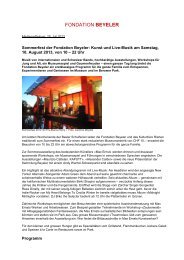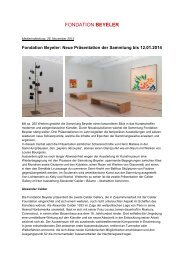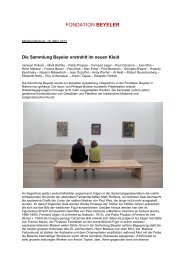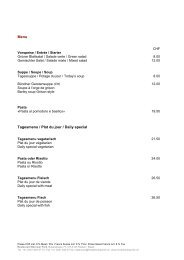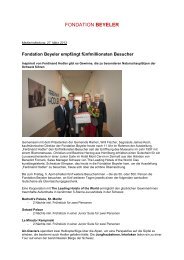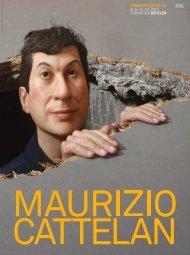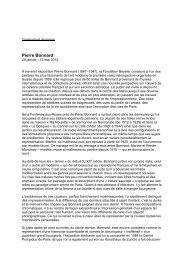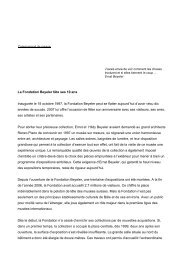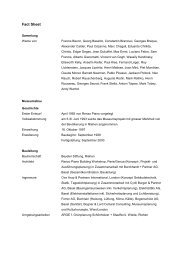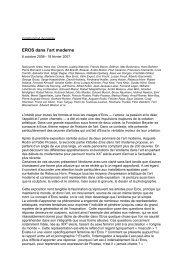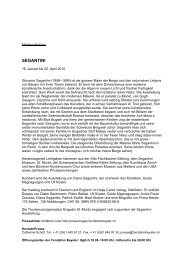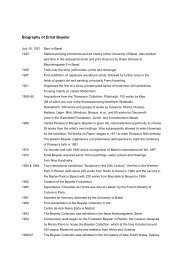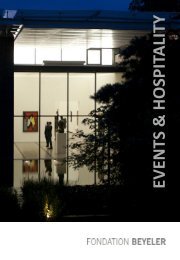"Jeff Koons" PDF - Fondation Beyeler
"Jeff Koons" PDF - Fondation Beyeler
"Jeff Koons" PDF - Fondation Beyeler
You also want an ePaper? Increase the reach of your titles
YUMPU automatically turns print PDFs into web optimized ePapers that Google loves.
INFORMATION SHEETS E<br />
May 13 to September 2, 2012<br />
FONDATION BEYELER<br />
Saalheft_E_Koons.indd 1 09.05.12 12:48
aTTENTioN: Please do not touch the works of art!<br />
Extremely fragile paintings and sculptures are exhibited<br />
here. We kindly request you not to touch the works under<br />
any circumstances.<br />
This symbol in the exhibition refers to works discussed<br />
below. Please note the number and symbol on the exhibit<br />
labels and the corresponding number in the text.<br />
TABLE OF CONTENTS<br />
Introduction 4<br />
ROOM 1 THE NEW 5<br />
ROOM 2 BaNaliTy 8<br />
ROOM 3 BaNaliTy 9<br />
ROOM 4 BaNaliTy 10<br />
ROOM 5 CElEBraTioN 12<br />
ROOM 6 CElEBraTioN 13<br />
ROOM 7 CElEBraTioN 14<br />
ROOM 8 CElEBraTioN 16<br />
ROOM 9 Works realised after CElEBraTioN 17<br />
FLORAL SCULPTURE IN THE PARK – SPliT-roCKEr 18<br />
Biography of <strong>Jeff</strong> Koons 20<br />
Further information 22<br />
Catalogue 23<br />
Room Plan 24<br />
Saalheft_E_Koons.indd 2-3 09.05.12 12:48<br />
3
INTROdUCTION<br />
The <strong>Fondation</strong> <strong>Beyeler</strong> is presenting the first exhibition ever<br />
devoted by a Swiss museum to the American artist <strong>Jeff</strong> Koons<br />
(b. 1955). Koons, likely the best-known living artist, has for<br />
decades been causing a furore with the combination of popular<br />
and high culture that informs his art.<br />
Our extensive presentation focuses on three central series of<br />
works – The New, Banality and Celebration – which represent<br />
crucial stages in Koons’s development and lead to the nucleus<br />
of his thinking and creative activity. The New comprises the ready-<br />
made-like cleaning appliances of his early period, symbols<br />
of newness and purity. Banality includes those traditionally<br />
crafted sculptures in porcelain and wood which have since<br />
become (post-)modern icons. Finally, the Celebration series, on<br />
which Koons has been working for almost twenty years, features<br />
high-gloss steel sculptures of unique material perfection, and<br />
large-format paintings in which the artist celebrates childhood<br />
in a veritably baroque way.<br />
Koons’s equally spectacular and subtle works are repeatedly<br />
concerned with themes such as innocence, beauty, sexuality<br />
and happiness. These reflect his conception of an art that is<br />
accessible to every viewer.<br />
In parallel with the exhibition, two Koons outdoor sculptures<br />
will be on view in the park of the <strong>Fondation</strong> <strong>Beyeler</strong>. One,<br />
Balloon Flower (Blue), installed in the North Pond, demonstrates<br />
the artist’s mastery of material illusion. The other, Split-Rocker,<br />
a monumental floral sculpture composed of thousands of real<br />
plants, establishes an unprecedented dialogue between art<br />
and nature.<br />
ROOM 1 THE NEW<br />
About the series The New<br />
From early on in his career, <strong>Jeff</strong> Koons has created his works<br />
in closed series to which he has given their own titles. The first<br />
series that he planned as such from the start is entitled The<br />
New. Koons conceived the works in this series between 1980<br />
and 1982, although their production continued until 1987.<br />
The first room in the exhibition is entirely dedicated to this<br />
early series, which occupies a crucial place in Koons’s artistic<br />
development.<br />
1 • The New <strong>Jeff</strong> Koons, 1980<br />
The exhibition opens with the programmatic work The New<br />
<strong>Jeff</strong> Koons. This work consists of a light box containing a black<br />
and white photograph that shows the artist as a child posing<br />
self-confidently at a desk, with crayons and a colouring book in<br />
front of him. In this work, Koons celebrates the child not just<br />
as the source of creativity but also as a symbol of integrity,<br />
innocence and purity. These central ideas in The New series<br />
constitute the key themes of Koons’s art.<br />
2 • New Hoover Quik-Broom, New Hoover Celebrity iV;<br />
New Hoover Deluxe Shampoo Polishers; The New;<br />
New Hoover Celebrity iiis, 1980<br />
Works in which Koons uses new, unused vacuum cleaners and<br />
shampoo polishers are particularly characteristic of the series<br />
The New. As early as 1980, his first vacuum cleaner objects<br />
were exhibited as a window installation in the New Museum<br />
of Contemporary Art in New York. For the present show, this<br />
display has been reconstructed using the originals. They include<br />
three works with suspended vacuum cleaners and shampoo<br />
polishers as well as a light box with the caption “The New”,<br />
which alludes to the New Museum while also having given the<br />
series its name. “Newness” provides the conceptual foundation<br />
for the entire series. From an art historical viewpoint, Koons’s<br />
cleaning appliances belong to the tradition of the ready-made,<br />
which Marcel Duchamp introduced into art in the early<br />
20 th century when he elevated mundane objets trouvés to the<br />
status of works of art.<br />
4 5<br />
Saalheft_E_Koons.indd 4-5 09.05.12 12:48
ROOM 1 THE NEW<br />
3 • New Hoover Convertibles, Green, red, Brown,<br />
New Shelton Wet/Dry 10 Gallon Displaced Doubledecker,<br />
1981–1987<br />
The series entitled The New is dominated by brand new cleaning<br />
appliances which are displayed lying or standing on fluores-<br />
cent lights in cube-shaped Plexiglas showcases. The showcases,<br />
which are presented singly or stacked on top of another,<br />
vary in size according to the number, type and positioning of<br />
the vacuum cleaners and/or shampoo polishers. Through the<br />
severity of their presentation and the use of neon tubes, these<br />
works evoke the reductive clarity of Minimal Art. As objects,<br />
Koons’s explicitly unused and therefore immaculate cleaning<br />
appliances embody “ideal newness”, standing for eternity and<br />
purity, like the portrait of the young artist in The New <strong>Jeff</strong><br />
Koons (no. 1).<br />
4 • New Shelton Wet / Drys Tripledecker, 1981<br />
Although his cleaning appliances were originally created as<br />
functional commercial objects, Koons does not simply present<br />
them as lifeless goods in coffin-like showcases. Instead he<br />
endows them with a kind of biological, living quality, seeing them<br />
as “breathing machines”. Inspired by the forms of the tubes and<br />
apertures, Koons also highlights the bisexual characteristics of<br />
the cleaning appliances, through which they in turn become a<br />
metaphor for original intactness. In Koons’s work, the cleaning<br />
appliances also symbolise the ideal of the reconciliation of<br />
opposites, as is emphasised by the model description “Wet / Dry”<br />
that features on some appliances’ casing and that is also<br />
included in the title of certain works.<br />
ROOM 1 THE NEW<br />
5 • New! New Too!, 1983<br />
Within The New, the celebration of newness is expressed not only<br />
through the cleaning appliance works but also through the large-<br />
format lithograph entitled New! New Too!, which is mounted<br />
on cotton. By taking a pre-existent advertising poster for a<br />
newly launched alcoholic beverage as his point of departure,<br />
Koons demonstrates his specific interest in commercial images<br />
and pictorial strategies. In keeping with their original function,<br />
these “posters”, together with the objects in showcases, were<br />
intended to directly communicate the series’ basic content to<br />
viewers. Koons’s fascination with the manipulative potential<br />
of images and his aspiration to make artworks as accessible<br />
as possible for viewers are manifested in this. As a picture on<br />
canvas, New! New Too! is also an early testimony to Koons’s<br />
preoccupation with monumental painting, which was only to be<br />
fully developed years later with the series entitled Celebration<br />
(Rooms 5, 6, 7 and 8).<br />
6 7<br />
Saalheft_E_Koons.indd 6-7 09.05.12 12:48
ROOMS 2, 3 ANd 4 BaNaliTy<br />
About the series Banality<br />
In 1988 Koons created his groundbreaking series entitled<br />
Banality, which was exhibited simultaneously in galleries in<br />
Cologne, New York and Chicago. In contrast to the series The<br />
New, in which he had still worked with minimalistically staged<br />
objects, he finally switched over to sculpture in Banality, while<br />
tending to orient his work more towards a baroque popular<br />
aesthetic. With his much-remarked Banality series, Koons not<br />
only placed the concept of art on a new foundation but finally<br />
also became a star on the international art scene. As a series,<br />
Banality consists of twenty sculptural figures of which every last<br />
detail was conceived by the artist. In an edition consisting of<br />
three unique versions and an artist’s proof, Koons had his<br />
sculptures created by professional artisans who signed each<br />
work very visibly with their name, while his signature was placed<br />
beneath the sculpture. As a group, the Banality figures form<br />
an extensive panorama in which Koons’s artistic programme<br />
finds its expression: “In Banality, I was trying to tell people to<br />
have a sense of security in their own past, to embrace their<br />
own past. This was the most direct way that I started to speak<br />
about people not letting art be a segregator.”<br />
ROOM 2 BaNaliTy<br />
6 • Ushering in Banality, 1988<br />
The key idea of the Banality series – that apparent banality<br />
can induce self-acceptance in viewers – finds particularly clear<br />
expression in the seminal polychrome wooden sculpture<br />
Ushering in Banality. As the work’s title indicates, a pig is being<br />
“ushered” into banality by two cherubs and a small boy, while<br />
itself becoming a symbol for the “banality” into which the<br />
observer is ushered. In his work, Koons not only gives the<br />
concept of banality a positive twist, but even elevates it to a<br />
fundamental artistic ideal. It is far from coincidental that the<br />
artist has identified himself with the red-clad boy behind the<br />
pig, who stands for the complicity between men and animals<br />
that typifies many of the works in the Banality series. With<br />
Ushering in Banality, as with the The New <strong>Jeff</strong> Koons (no. 1), it<br />
is the artist as a child who points the way.<br />
ROOM 2 BaNaliTy<br />
7 • Popples, 1988<br />
Several figures in the Banality series, among them Popples, are<br />
derived from doll-like children’s toys. As an endearing cuddly<br />
toy, Popples evokes the innocence of childhood but the fact<br />
that it is a doll made of rigid porcelain also gives it a monstrous<br />
quality. This game with the reconciliation of opposites also expresses<br />
itself in the materiality of the object, which looks soft<br />
but which is in fact hard. Through its material transformation<br />
and its elevation on a base, Popples stands for the dissolution<br />
of aesthetic categories like “art” and “kitsch” that characterises<br />
the whole of Koons’s oeuvre. The use of porcelain, which<br />
has evolved in the course of its history from a luxury good<br />
destined for princes to a product used daily by the bourgeoisie,<br />
gives tangible expression to the “democratisation” of art.<br />
ROOM 3 BaNaliTy<br />
8 • Buster Keaton, 1988<br />
In his works, Koons repeatedly alludes to images drawn from<br />
art history, which he transfers to figures in popular culture.<br />
The wooden sculpture Buster Keaton can accordingly be seen<br />
as a contemporary version of Christ astride the donkey he rode<br />
on Palm Sunday, which was a widespread motif in medieval<br />
art. In its tragicomic appearance, this sculpture of the star of<br />
the silent screen expresses the constant alternation between<br />
light-heartedness and seriousness that characterises much of<br />
Koons’s work. Like many traditional figures of saints, Koons’s<br />
Buster Keaton is made of wood: “When I work with wood it is<br />
so that people can feel the security of religion.” The materials<br />
chosen by Koons in fact always correspond to an emotional<br />
need.<br />
8 9<br />
Saalheft_E_Koons.indd 8-9 09.05.12 12:48
ROOM 3 BaNaliTy<br />
9 • Christ and the lamb, 1988<br />
The ornate mirror work Christ and the Lamb is a highly sophisticated<br />
visual puzzle at first suggested only by its title. The figure<br />
of the infant Jesus playing with the lamb from Leonardo da<br />
Vinci’s famous painting The Virgin and Child with St. Anne, now<br />
in the Louvre in Paris, is concealed in the contours of the gilt<br />
Rococo frame. Through the play of reflections, viewers see their<br />
image superimposed on the body of the infant Jesus, thereby<br />
themselves acquiring a sacred quality. Koons’s fundamental<br />
concept of an art that can elevate its viewers is thus achieved<br />
through the medium of the work itself, which in this case is<br />
object, sculpture and “painting” all at once.<br />
10 • Naked, 1988<br />
In many figures of the Banality series, Koons addresses the<br />
problem of guilt and exoneration, one of the central questions<br />
of human existence. In the porcelain sculpture Naked, a boy<br />
and girl stand in the nude on a pink heart adorned with brightly<br />
coloured flowers, with one arm on each other’s shoulder. The<br />
boy is holding out a bunch of flowers to the girl, but it is not<br />
clear whether she is paying more attention to the anthurium’s<br />
phallic pistil or to the boy’s still undeveloped genitals. Naked<br />
therefore plays on the traditional representation of Adam and<br />
Eve at the time of their fall from grace, while still maintaining<br />
the state of original innocence in which the two children find<br />
themselves. Many other Banality figures are based on a combination<br />
of purity and sexuality already thematised in Koons’s<br />
vacuum cleaner works from The New series.<br />
ROOM 4 BaNaliTy<br />
11 • Pink Panther, 1988<br />
Like Woman in Tub shown in the preceding room, the porcelain<br />
figure Pink Panther, which is reminiscent of a pin-up girl,<br />
belongs to those works which Koons, as he himself has put it,<br />
based on the motif of “masturbation as a metaphor for cultural<br />
guilt and shame”. The artist tries to liberate viewers from such<br />
feelings of guilt and shame by challenging them to stand up for<br />
their suppressed aesthetic preferences. Pink Panther is also a<br />
particularly vivid expression of the formal and compositional<br />
interest of Koons’s approach to sculpture. With its charged<br />
erotic relationship between woman and animal, Pink Panther<br />
is particularly striking because of the multiple viewpoints from<br />
which we can see its dynamically twisted figure, a feature derived<br />
from the Mannerist tradition of the “figura serpentinata”.<br />
ROOM 4 BaNaliTy<br />
12 • Stacked, 1988<br />
In this painted wooden sculpture, a pig, a goat, two dogs and a<br />
bird are “stacked” on top of one another in a tower-like construc-<br />
tion. The work’s structure can therefore be compared with the<br />
cleaning appliances piled up in showcases in Koons’s earlier<br />
series The New, which are presented in the first room of the<br />
exhibition. Carved by traditional craftsmen, the work Stacked<br />
can be seen as a new interpretation of the figures in the tale<br />
“The Town Musicians of Bremen” and is thus a good example<br />
of how Koons frequently refers to European folk art, which<br />
corresponds to his desire for an art accessible to all.<br />
13 • Michael Jackson and Bubbles, 1988<br />
<strong>Jeff</strong> Koons’s legendary porcelain work Michael Jackson and<br />
Bubbles, described by him as a contemporary “Pietà”, has today<br />
itself become a post-modern icon. The superstar who has been<br />
exalted to a monument is shown posing in the work, surrounded<br />
by golden roses, heroically like a modern Orpheus. His chimpanzee<br />
Bubbles is resting on his lap, looking as artificial as its human<br />
counterpart. In his ambivalence, Michael Jackson stands for the<br />
elimination of sexual, ethnic, aesthetic and social distinctions<br />
in one person, thereby corresponding to Koons’s ideal of an<br />
“anti-discriminatory” art reconciling all opposites, through<br />
which he attempts to reach the largest possible audience.<br />
14 • Wishing Well, 1988<br />
By using mirror glass, Koons resorts to a material that directly<br />
involves viewers in the work because of its reflective quality. The<br />
incorporation of a mirror therefore also corresponds to Koons’s<br />
fundamental view that art should be accessible to all. His belief<br />
that an artwork should reveal viewers’ suppressed yearnings<br />
is particularly demonstrated by the mirror work Wishing Well.<br />
Here, the mirror serves as a means for self-reflection and selfseduction<br />
by viewers, who can see and “find” themselves in it.<br />
10 11<br />
Saalheft_E_Koons.indd 10-11 09.05.12 12:48
ROOMS 5, 6, 7 ANd 8 CElEBraTioN<br />
About the series Celebration<br />
Originally conceived as a small project for a calendar, Celebration<br />
has since developed into Koons’s most elaborate series to date.<br />
From 1994 onwards, Koons was involved for many years in<br />
this massive project, which consists of monumental sculptures<br />
made of polyethylene or high chromium stainless steel as well<br />
as large-format oil paintings. The history of the creation of<br />
Celebration is closely tied up with events in Koons’s family life,<br />
particularly the birth of his son Ludwig Maximilian in 1992. In<br />
its character as a feast of the childlike, the Celebration series<br />
can also be seen as a token of the father’s love for the son who<br />
was taken away from him.<br />
ROOM 5 CElEBraTioN<br />
15 • Cat on a Clothesline (aqua), 1994–2001<br />
One of the earliest sculptures in the Celebration series is<br />
Cat on a Clothesline (Aqua), which is made of polyethylene.<br />
Like all the Celebration sculptures, it was created in an edition<br />
of five differently coloured unique versions. Koons’s inspiration<br />
for Cat on a Clothesline came from a photograph of a kitten<br />
hanging in a sock that he had used shortly before for another<br />
art project. In Cat on a Clothesline, the cat is pegged on a<br />
washing line between two enormous flowers, looking out in a<br />
somewhat puzzled way from a turquoise sock. Among other<br />
things, this droll representation evokes a crucifixion motif,<br />
thereby once again embedding Koons’s work in the Christian<br />
iconographical tradition.<br />
ROOM 6 CElEBraTioN<br />
16 • Play-Doh, 1995–2007<br />
With the Celebration series, Koons accomplishes the actual<br />
transition to painting, which is placed on an equal footing with<br />
sculpture for the first time in his career. Most of the large-<br />
format Celebration paintings, including the masterly Play-Doh,<br />
are based on the same basic compositional principle: the<br />
central pictorial subject is displayed in front of draped glossy foil,<br />
in which individual parts of the object, generally distorted, are<br />
seductively reflected many times over. The Celebration paintings<br />
are inspired by actual arrangements of objects assembled by the<br />
artist himself. These motifs are subsequently photographed and<br />
reworked before being carefully transferred to the canvas in a<br />
significantly enlarged format. Aesthetically, the paintings catch<br />
the eye due to their “objective” or even hyper-realistic impact,<br />
although the canvas, following the principle of “painting by<br />
numbers”, is divided into colour fields that are rigorously sepa-<br />
rated from each other. In Play-Doh, Koons transforms a motif<br />
taken from childhood into a powerful, sensuous spectacle in<br />
which the repeatedly reflected figure seems to dissolve into an<br />
almost abstract colour composition.<br />
17 • Party Hat, 1995 –1997; Cake, 1995 –1997<br />
In the Celebration series, most of the motifs relate to children’s<br />
festivities such as birthday parties. This is also true of the<br />
colourful cardboard hat in Party Hat and the decorated slice<br />
of cream cake in Cake, through which Koons pays tribute to<br />
childhood in general, thereby carrying on from the subject<br />
matter of the two earlier series shown in this exhibition,<br />
The New and Banality. In their compositional simplicity and<br />
visual directness, these paintings seem to be no more than<br />
memorably eye-catching, but closer examination shows that<br />
their “inner” structure is highly complex and differentiated.<br />
Stylistically, the paintings in the Celebration series represent<br />
a synthesis of the minimalist aesthetic of The New and the<br />
baroque opulence of Banality.<br />
12 13<br />
Saalheft_E_Koons.indd 12-13 09.05.12 12:48
ROOM 6 CElEBraTioN<br />
18 • Hanging Heart (Gold / Magenta), 1994–2006;<br />
Cracked Egg (Blue), 1994–2006<br />
The works in the Celebration series emphasise familiar decora-<br />
tive items that, through material transformation and rescaling,<br />
are elevated to monumental sculptures made of high chromium<br />
stainless steel. These items include gift articles for Christmas<br />
and St. Valentine’s Day, such as that which inspired the<br />
extremely symbolic work Hanging Heart. Other subjects in this<br />
series can be linked with different highpoints in the holiday<br />
calendar, for example Cracked Egg with Easter. In their symbolism,<br />
these motifs often evoke timeless themes like love,<br />
life and transience.<br />
ROOM 7 CElEBraTioN<br />
19 • Balloon Dog (red), 1994–2000<br />
Air-filled objects have interested Koons from the beginning of<br />
his career, as is demonstrated by his use of vacuum cleaners<br />
in his early work. Numerous works in the Celebration series are<br />
inspired by the balloon figures modelled by street clowns. In<br />
Balloon Dog (Red), for example, Koons transforms a delicate,<br />
transient balloon dog into a huge archetypal dog made of<br />
durable stainless steel that Koons himself describes as a<br />
“Trojan horse”. In its perfect execution, Balloon Dog (Red) is<br />
remarkable for the illusionism of its material – the sculpture<br />
looks soft and lightweight but is actually hard and weighs<br />
several tons.<br />
ROOM 7 CElEBraTioN<br />
20 • Tulips, 1995–2004; Balloon Flower (Blue), 1995–2000<br />
(installed in the pond outside the exhibition room)<br />
Flowers are a leitmotiv in Koons’s art – a traditional symbol of<br />
beauty, life and transience. The artist adds an erotic dimension<br />
that is typical of him. This is true of the virtuoso stainless<br />
steel sculptures seen here: Tulips, installed in this room, and<br />
Balloon Flower (Blue), which you will notice when you look<br />
out of the window. The simple but ambivalent forms of the<br />
flowers contain both male and female characteristics. An idea<br />
already thematised by the vacuum cleaners in The New and<br />
by a number of the Banality figures is therefore once again<br />
expressed here. The surrounding space and the viewer are<br />
reflected in the immaculate, seductively shiny surfaces of<br />
Tulips and Balloon Flower (Blue), thus entering into a direct<br />
relationship with the work of art. Balloon Flower (Blue) seems<br />
to be swimming on the surface of the water, achieving a<br />
wonderfully weightless effect in the setting of the pond.<br />
21 • Tulips, 1995 –1998<br />
Placing the sculptural and the painted version of Tulips side<br />
by side gives very visible expression to the specific and remark-<br />
able interaction between painting and sculpture characteristic<br />
of Koons’s Celebration series. This interaction is also demonstrated<br />
inside the work of art itself: the object in the Tulips<br />
painting is reproduced many times over through the multiple<br />
reflections in the background. Koons thereby highlights the<br />
painted object’s sculptural quality, just as he accentuates the<br />
painterly dimension of his Tulips sculpture by emphasising<br />
colour and surface. What we encounter here is therefore a<br />
remarkable interplay between the genres of object art, sculpture<br />
and painting.<br />
14 15<br />
Saalheft_E_Koons.indd 14-15 09.05.12 12:48
ROOM 8 CElEBraTioN<br />
22 • Donkey, 1996 –1999<br />
Donkey and Shelter (no. 23), the large-format paintings shown<br />
in this room, are some of the last in the Celebration series.<br />
In both of them, Koons abandons glossy foil for the picture’s<br />
background, instead using a large number of different pictorial<br />
elements that he combines in a kind of collage. Both paintings<br />
feature various toy figures that dominate the pictorial composition.<br />
In Donkey, we see a cute donkey with yellow gym shoes<br />
in front of a collection of toy objects that extend over the entire<br />
canvas. To the right we see a selection of different tails – an<br />
invitation to us to pick the appropriate tail for the donkey. We<br />
thereby become a child-like player and the work transmits the<br />
yearnings of childhood.<br />
23 • Shelter, 1996 –1998<br />
Like Donkey (no. 22), Shelter can also be interpreted as a<br />
surface for projecting childhood desires. Amidst the brightly<br />
coloured accumulation of laughing toy figures shown before a<br />
range of mountains, we also find the two figures – the green<br />
dinosaur’s head on the left and the yellow pony’s head on the<br />
right – whose half-faces provide the motif for the monumental<br />
flower sculpture Split-Rocker in the park of the <strong>Fondation</strong><br />
<strong>Beyeler</strong>.<br />
ROOM 9 Works realised after CElEBraTioN<br />
24 • Elephant, 2003<br />
The three stainless steel sculptures exhibited in this last room<br />
are figures that were created after the Celebration series. As<br />
if they were two sentries, the comic-like figures Elephant and<br />
Titi stand at the entrance watching over the proud, dominant<br />
Balloon Swan (Magenta) (no. 25) in the middle of the room. In<br />
comparison to the Balloon Swan (Magenta), the little Elephant<br />
at first seems to be delicate and cute, but its contours also<br />
simultaneously suggest a powerful being, whose ears turn into<br />
muscular arms. In this work, once again, Koons reflects on the<br />
diverse nature of form.<br />
25 • Balloon Swan (Magenta), 2004–2011<br />
Balloon Swan (Magenta), which was completed only recently<br />
and which is being exhibited for the very first time, is a sculpture<br />
created in the formal idiom of the Celebration series, while<br />
also pointing into the future. The swan with its raised head is<br />
enthroned majestically before us, capturing our entire attention<br />
by its elegant physical presence: the toy has turned into a cult<br />
figure.<br />
16 17<br />
Saalheft_E_Koons.indd 16-17 09.05.12 12:48
FLORAL SCULPTURE IN THE PARK<br />
Split-rocker, 2000–2012<br />
Split-Rocker, a colossal floral sculpture comprising thousands<br />
and thousands of real plants, will be on view in the park of<br />
the <strong>Fondation</strong> <strong>Beyeler</strong>. The sculpture continues the compelling<br />
dialogue between art and nature that has become so characteristic<br />
of the <strong>Fondation</strong> <strong>Beyeler</strong>. Split-Rocker was first installed<br />
in 2000, in the cloister of the Palais des Papes in Avignon, then<br />
again a few years later in the gardens of Versailles (2008). Now<br />
Split-Rocker has begun to flourish in Riehen.<br />
For his floral sculpture, Koons proceeded from two different<br />
rocker motifs, a pony and a dinosaur, whose heads he cut in half<br />
and then reassembled. Since the halves do not coincide, gaps<br />
are formed at certain places which open the sculpture out and<br />
transform it into a structure that offers refuge. A disassembled<br />
and differently reassembled figure that simultaneously looks<br />
forward and to the side, Split-Rocker relates to the Cubism of<br />
Picasso while at the same time turning it in an entirely new<br />
direction. As an outdoor floral sculpture, the piece also continues<br />
the tradition of Baroque garden art and the topiary gardening<br />
still seen today in popular amusement parks.<br />
With the combination of pony and dinosaur, Split-Rocker<br />
embodies that confrontation of opposites that is also expressed<br />
in the notion of a “monstrous”, gigantic children’s toy. Yet the<br />
artist chooses transitory flowers, of all things, as the material<br />
for a monument that promises duration. It is not least in this<br />
special interplay of supposed opposites that the true tension<br />
and force of Koons’s art lie.<br />
<strong>Jeff</strong> Koons, 2012<br />
18 19<br />
Saalheft_E_Koons.indd 18-19 09.05.12 12:48<br />
PHoto: Chris Fanning
BIOgRAPHY OF JEFF KOONS<br />
1955<br />
<strong>Jeff</strong> Koons is born in York, Pennsylvania, where he spends his<br />
childhood.<br />
1972–76<br />
Studies art and design at the Maryland Institute College of<br />
Art in Baltimore. In 1975 he spends an exchange year at the<br />
School of the Art Institute of Chicago. The following year he<br />
leaves Chicago for New York.<br />
1977<br />
Koons works at The Museum of Modern Art, New York, acquiring<br />
new museum members. Until 1979 he develops his first series of<br />
works, consisting of combined ready-mades in which inflatable<br />
figures are placed on and in front of mirrors.<br />
1979<br />
Begins to work with household appliances, which he affixes to<br />
fluorescent lamps for a series later titled Pre-New. Executes first<br />
work with a vacuum cleaner. Koons is employed as a broker on<br />
Wall Street in order to finance the production of his art.<br />
1980<br />
Koons installs his first show in the display window of the New<br />
Museum of Contemporary Art, New York, out of which he will<br />
develop the series The New.<br />
1983<br />
Sketches the first water tanks for the Equilibrium series.<br />
1985<br />
Koons has his first true one-person show, at the gallery International<br />
With Monument, New York.<br />
1986<br />
The series Luxury and Degradation and Statuary emerge, all of<br />
the sculptures of which consist of stainless chrome steel.<br />
1987<br />
Koons is invited to “Skulptur Projekte Münster” in Germany, and<br />
creates Kiepenkerl in stainless chrome steel.<br />
1988<br />
Koons’s new series, Banality, is simultaneously shown in three<br />
distinguished galleries in Cologne, New York and Chicago. The<br />
porcelain and wood figures mystify the critics.<br />
1991<br />
The Made in Heaven series is shown in Cologne and New York.<br />
The works, showing the artist making love with Ilona Staller,<br />
alias Cicciolina, are largely panned by the critics. Koons and<br />
Staller marry.<br />
1992<br />
Koons creates the monumental floral sculpture Puppy in front<br />
of the castle in Bad Arolson near Kassel. Large museum<br />
retrospectives are held in Amsterdam, Stuttgart, San Francisco,<br />
and Minneapolis.<br />
1993<br />
Inspired by his little son, Ludwig Maximilian, Koons develops the<br />
extensive series Celebration, comprising colored chrome steel<br />
and polyethelene sculptures and paintings. Koons separates<br />
from Ilona Staller, and a protracted struggle for custody of<br />
their son begins.<br />
1999<br />
Koons begins a new series, Easyfun, comprising paintings and<br />
wall-mounted sculptures.<br />
2000<br />
Designs Split-Rocker, his second floral sculpture, which is first<br />
shown at the Palais des Papes in Avignon. He begins a new series<br />
of paintings, Easyfun-Ethereal.<br />
2002<br />
A new series of sculptures and paintings, Popeye, is commenced.<br />
Koons weds Justine Wheeler.<br />
2004<br />
Koons is honored with retrospectives in New York, Oslo and<br />
Helsinki.<br />
2006<br />
Begins working on a new series, Hulk Elvis.<br />
2008<br />
Large-scale exhibitions in Chicago, New York, Berlin, and in the<br />
Palace of Versailles, are devoted to Koons. He starts working<br />
on the new series Antiquity.<br />
2012<br />
The <strong>Fondation</strong> <strong>Beyeler</strong> stages the first exhibition of Koons’s<br />
work ever held in a Swiss museum, soon to be followed by a<br />
Koons exhibition in Frankfurt am Main.<br />
20 21<br />
Saalheft_E_Koons.indd 20-21 09.05.12 12:48
FURTHER INFORMATION<br />
Texts: Raphaël Bouvier<br />
Editing: Ioana Jimborean<br />
Translation: Isabel Feder<br />
We look forward to hearing your feedback at<br />
fondation@fondationbeyeler.ch<br />
Download the free <strong>Jeff</strong> Koons Clip<br />
Split-Rocker App for<br />
iPhone and iPad<br />
from June 8, 2012<br />
Follow us:<br />
www.fondationbeyeler.ch/en/news<br />
www.facebook.com/<strong>Fondation</strong><strong>Beyeler</strong><br />
twitter.com/Fond_<strong>Beyeler</strong><br />
QR code generated on http://qrcode.littleidiot.be<br />
FONDATION BEYELER<br />
Baselstrasse 101, CH-4125 Riehen / Basel<br />
www.fondationbeyeler.ch<br />
CATALOgUE<br />
JEFF KOONS<br />
Exhibition catalogue, published by Hatje Cantz<br />
212 pages, 80 illustrations, CHF 68,–<br />
With a conversation between <strong>Jeff</strong> Koons and Theodora Vischer<br />
as well as essays by Raphaël Bouvier and Günther Vogt.<br />
22 23<br />
Saalheft_E_Koons.indd 22-23 09.05.12 12:48
Art Shop<br />
Entrance Museum<br />
Foyer<br />
3<br />
2<br />
1<br />
JEFF KOONS<br />
Collection<br />
Calder Gallery<br />
(Start: 10.6.2012)<br />
Works realised after<br />
CELEBRATION<br />
9<br />
CELEBRATION<br />
North Pond<br />
7<br />
4<br />
7<br />
BANALITY<br />
CELEBRATION<br />
3<br />
8<br />
5<br />
THE NEW<br />
BANALITY<br />
BALLOON<br />
FLOWER<br />
(BLUE)<br />
Philippe Parreno<br />
(Start: 10.6.2012)<br />
8<br />
1<br />
BANALITY<br />
4<br />
CELEBRATION CELEBRATION<br />
6<br />
2<br />
5<br />
6<br />
Video<br />
Winter Garden Lift<br />
Souterrain (lower oor)<br />
JEFF KOONS<br />
BEYELER COLLECTION and works from the DAROS COLLECTION<br />
21<br />
Philippe Parreno<br />
(Start: 10.6.2012)<br />
20 22<br />
Matisse<br />
Acanthes<br />
Philippe Parreno<br />
(Start: 10.6.2012)<br />
ATTENTION: Please do not touch the works of art!<br />
Extremely fragile paintings and sculptures are exhibited here.<br />
We kindly request you not to touch the works under any circumstances.<br />
Saalheft_E_Koons.indd 24 09.05.12 12:48<br />
Lift<br />
Philippe Parreno<br />
Souterrain



